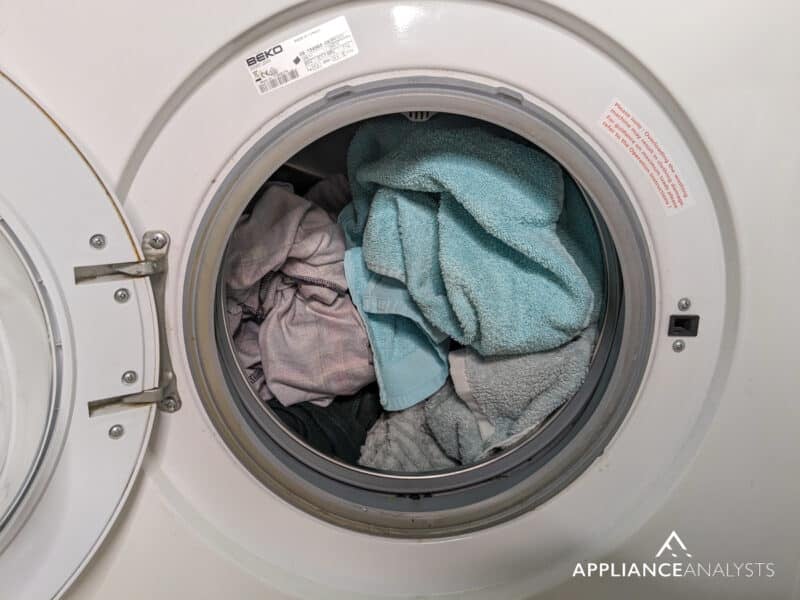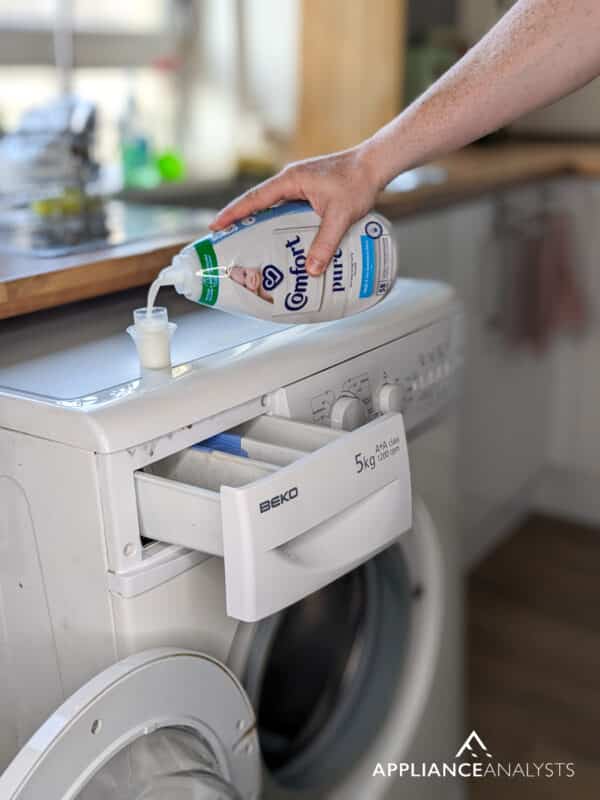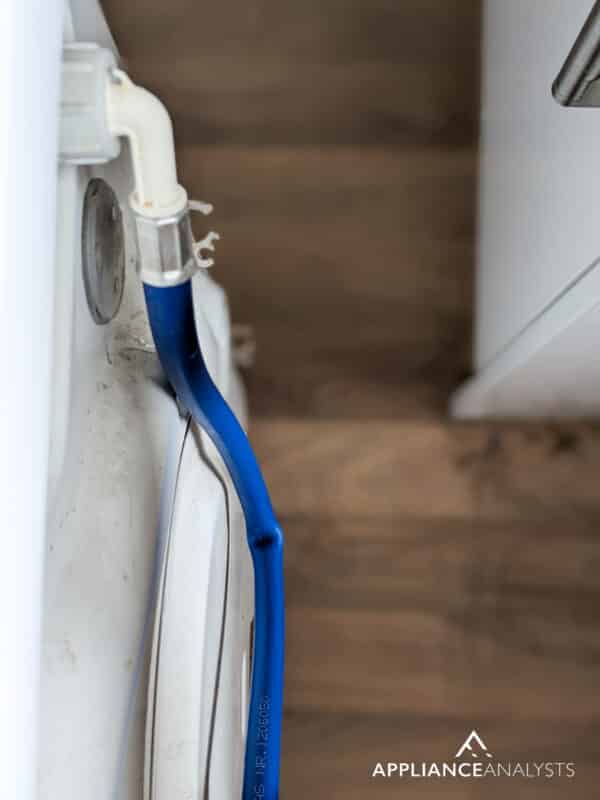We've independently reviewed this article to make sure it's as accurate as we can make it.
To find out more about our article creation and review process, check out our editorial guidelines.
Is your washer leaving leftover detergent or suds on your clothes?
That sucks! Opening your washer only to notice that your clothes are still covered in detergent can be quite frustrating.
Luckily, you’ve come to the right place to fix the issue.
If your washer is leaving detergent or suds, chances are you’re overloading the machine, using too much product, or dealing with hard water. If the issue persists, it’s possible that the hoses are not installed correctly, the detergent drawer is dirty, or you’re experiencing water flow and valve issues.
Read on to get clean clothes again!
Fixing Suds and Detergent Residue in Your Washer: 6 Steps
In this section, I’ll guide you through the different solutions you can try to fix the excess detergent and suds issue in your washer.
Are you ready? Let’s dive in!
#1 Avoid Overloading Your Washer
When fixing a washer that leaves detergent or suds on clothes, I always check the size of the load.
You see, overloading your washing machine can keep your clothes from moving freely and being properly agitated. It can also affect the water flow and drainage. As a result, your detergent won’t be able to dissolve fully.
Aim to fill only 75% of the drum to prevent detergent residue or suds and ensure the best cleaning results. Make sure your clothes have enough room to move freely.

#2 Use the Right Amount of Product
If you’re still struggling with a washer that leaves detergent or suds on your clothes, please check the amount of product you’re using.
Homeowners often think that using more detergent gives them ultra-clean clothes; however, it actually works the other way around. Too much suds can become trapped in the clothes, requiring an extra rinse cycle.
The easiest way to solve the issue is by reading your washer’s manual and the product labels for recommended filling instructions. Using the measuring cup and adjusting the product amount based on the load size is also important.
Keep in mind that overfilling the fabric softener compartment can also lead to stains or residue on your clothes, as it dispenses too early in the wash cycle. I’ve noticed that it often looks like oil stains. Don’t forget to read the product label, as certain fabric softeners must be diluted before use.

#3 Check for Hard Water Issues
In my experience, hard water can also contribute to detergent buildup in your washing machine.
When hard water flows through your washer’s valve, it can leave mineral deposits behind, affecting the water flow rate and your detergent’s effectiveness. It can form a sticky residue that can remain on your clothes.
So, if you’re dealing with hard water, try using a water softener and choosing a detergent specifically formulated for hard water.
It’s also important to clean your washing machine once a month to prevent mineral buildup. You can use a commercial cleaner to do so.

If you prefer a natural alternative, set your washer to the hottest setting, longest cycle, and largest load. Then, add 2-3 cups of vinegar and 1/2 cup of baking soda. Run the cycle and wipe the drum and door with a cloth. Don’t forget to clean the seals and let the machine dry to prevent mold.
#4 Examine the Water Hoses
If your washer is still leaving leftover detergent or suds on your clothes, I recommend checking the water hoses.
You see, different parts of the dispenser drawer rely on either hot or cold water to correctly siphon the detergent, fabric softener, and bleach. So, if you accidentally switch the hot and cold water hoses, it could affect the dispenser mechanism and result in leftover detergent on your clothes.
Typically, washer hoses are marked with an “H” or are colored red to indicate hot water, while a “C” or blue color means cold water. Match the colors and labels correctly with the respective water inputs.
It’s also important to ensure the hoses are not kinked. If you notice any signs of damage, please replace them with new ones.

If you want to get any replacement part – or see how much one would cost – click to enter your model number in the search bar below. Our partners at AppliancePartsPros stock almost every part with free guides on how to install them.

#5 Clean The Dispenser Drawer
Believe it or not, a dirty detergent drawer is a common culprit behind issues like leftover detergent or suds on clothes.
You see, most washer drawers dispense the detergent, fabric softener, and bleach at the appropriate time during the wash cycle. Unfortunately, if the drawer has detergent buildup, the dispenser mechanism will be less efficient, leading to poor cleaning performance.
Follow these instructions to clean your washer’s dispenser drawer:
- If possible, pull out the detergent drawer gently. Please read the manufacturer’s manual for detailed instructions.
- Use warm soapy water or a mixture of warm water and vinegar to clean the drawer. Pay special attention to the corners and small holes.
- Rinse the dispenser drawer thoroughly under water to remove the vinegar or soapy water residue.
- Allow the drawer to dry before reassembling it to prevent mold.
- Once the drawer is dry, reassemble it.
Note: If you can’t remove your washer’s dispenser drawer, pull it out as far as it will go and use a pitcher of hot water and a toothbrush to scrub it.
#6 Check the Water Valve
If you’ve tried all of the fixes above, but your washing machine is still leaving detergent or suds on your clothes, you must inspect the water valve.
The water valve is located at the back of your washer and is responsible for controlling the flow of water.

When you start a washing cycle, the control system sends a signal to the water valve to open, allowing water to flow into the drum. Once the right water level is reached, the valve closes.
Unfortunately, if water flows too quickly or too slow, your washer’s siphoning mechanism will not work correctly, leading to detergent residue or excessive suds.
In my opinion, fixing a water valve issue is typically one of the easiest and most affordable repairs for a washing machine. Here’s how to do it:
- Turn off the water supply and unplug your washer from the power outlet.
- Open the washing machine’s panel to access the water valve. You’ll probably need to remove some screws.
- Disconnect the water hoses from the valve. My usual advice is to place some towels underneath to catch any water spills.
- Remove the water valve and replace it with a new one.
- Reattach the water hoses to the new valve and secure the panel back in place.
Once you’ve replaced the water valve, please plug your washer back in and run a cycle. Check if the leftover detergent issue has been solved.
Please keep in mind that if you don’t feel comfortable replacing the water valve, you should call a professional.
Tackling Detergent Residue and Suds in Your Washer
Hopefully, now you know how to keep your washing machine from leaving leftover detergent or suds on your clothes.
Remember to avoid overloading your washer to ensure that your clothes move freely and the detergent can effectively dissolve. It’s also important to use the right amount of products, check for hard water issues, and clean the dispenser drawer regularly.
Don’t forget to make sure that the water hoses are properly installed. And if the issue persists, consider replacing the water valve with a new one.
Thank you so much for taking the time to read this guide. If you ever experience a different issue with your washing machine or any other appliance, please check out our site. We love solving all sorts of issues.
Have a wonderful day!









